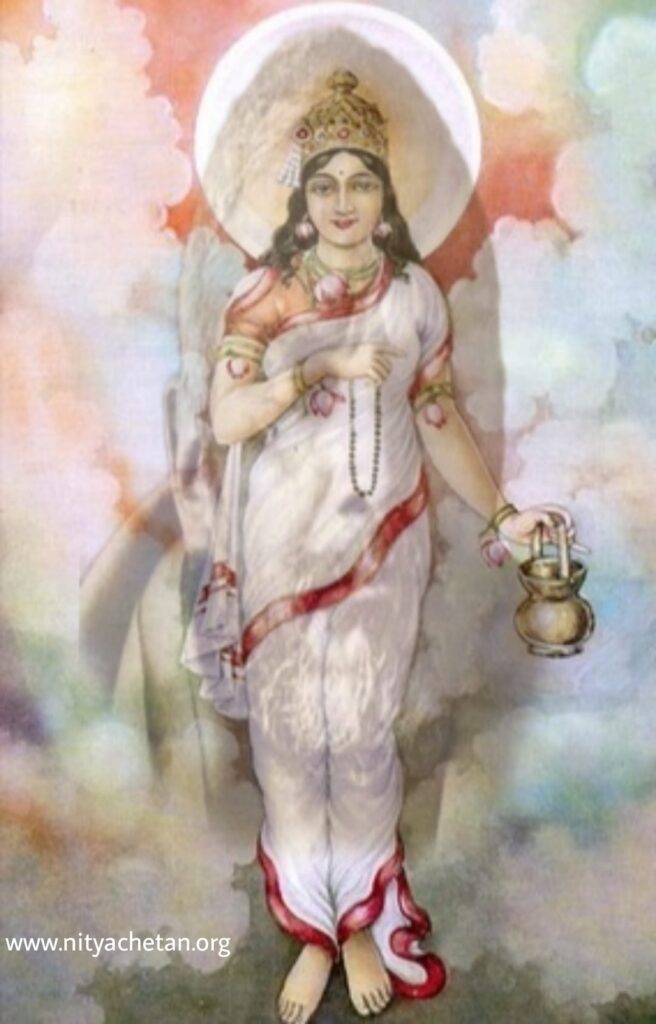
Chapter 2 Summary
Praying for boons: Centering the unconditional, unsurpassing love within one in the Paramananda Svarupa Devi (supremely blissful form of Devi), is called as Devotion.
It is not the nature of a true devotee to seek solution for sadness, or ask for impure, toxic mundane desires. It wise to pray ‘your darshan itself is impossible, bestow me your darshan, everything else compared to it is insignificant, please grant me a boon to have steadfast devotion in you ever’, such desirelessness is quintessential. It is foolishness to ask for a piece of glass when one has precious gem in hand, it is like desiring for an infertile cow when the Kamadhenu (boon giving celestial cow) is available, similarly instead of seeking the Devi who bestows the Supreme bliss, those are fools who ask for worldly wants. Desire for boons is like ‘seeking sorrows and wretchedness’, but when one does not desire anything , one has asked for everything! As the Shruti says ‘Anicchaiva Paramam Padam’, having no desires itself is the form of Devi, it’s the greatest of boons.
Forgetfulness – Since it is insane to forget the God who has given you the body and all other forms of wealth, you loose yourself in the worldly transactions wearing a body. The desire to have boon or not, the awareness to forget, the ownership of all this business of giving, receiving, all this is our own delusion. Without Devi’s divine will, no Gods, demons and humans have even a little of freedom. One must forsake the ego and pride that I protect my wife and children, everything is done by me and realize that everything related to the body and the entire world is happening through the omnipresent and omnipotent Shakti alone. She is the only doer of everything. One must learn to imbibe that ‘everything I do is done by her through me’. With this attitude, one must know that, everything in the universe will support us.
Oneness/ undividedness: Vyasa lost his arms by reproaching Hara and praising Hari. Hiranyakasyapa lost his life by reproaching Hari and praising Hara. Hence differential attitude is the misery. It is lowness to find differences in Hari- hara and such when the Shrutis and other religions enunciate that there is only one God. Although many people worship the same source in different Name and forms due to differences in time and region, such as Shiva, Narayana, Ishvara, Purusha, Shunya, Rama, Rahima etc., the symbolic meaning of those names is concerned with the original source itself. And though the same source appears different due to differences in name, form and acts, in reality the same Chicchakti is functioning without any differences, Brahma while creating the srishti, Vishnu while protecting it, Rudra to alleviate the sin and sufferings of devotees, Ishvara while bestowing the desired boons, and Sadashiva in the time of salvation. Though these are the different forms, the source is the same. Emotion is like Kalpavriksha (celestial boon giving tree), as you feel so you reap its fruit. One who is always percieves oneness, attains liberation. The visible idols are not the Gods but the all witnessing awareness in them is the real God. One must realize that the Pure awareness is the same in all the idols and attain real joy. This way those who perceive with a sense of Oneness that all the idols are the form of the same Shakti, merge in Brahma!
Chapter 3 Summary
Adjudication of Trimurtis – That object does not appear outside since it is prepared inside. Because one must understand that the one who has the power to create 14 worlds (5 emeralds, 5 senses, 5 impulses) protect and dissolve the world, he has all the 14 worlds in his belly and hence it was decided that he to be the eldest.
Vishnu is the ruler for Gross body- wakefulness because it’s in him the conserving the 14 worlds happen. Brahma is the ruler of the subtle body-dream state as the transactions of creation occur.
Rudra is the ruler of sleep state since all the happenings in Causal body- wakeful and dream states dissolve in sleep. Satva Gun is active in Wakeful state, Rajo Gun in dream, and Tamo Gun in sleep. Thus, Brahma swallowed Rudra (the Tamo gun who knows nothing) and Vishnu (awareness of knowledge). That is, he assumed Kalpanamaya sharir (imaginary body). Both of them saw the Manomaya Srishti (creation of mind) of Brahma like his Kalpanamaya Srishti (imaginary creation). Ultimately, Lord Shiva, beyond the imagination, became unaware of everything (and went to sleep) and Vishnu descended down. That is to say, attaining Brahmadrishti, he came into Awareness.
Banyan Leaf- Banyan-Nature | Leaf-petal | Vishnu in the state of wakefulness, slept in the eight petals of lotus of heart. That is, devoid of all vasanas (inclinations) , he got absorbed in the form of Shakti. Brahman also came out of Vishnu’s Nabhikamal after seeing the 14 worlds.
The face of Brahma – The four aspects as he sees in the four directions (bliss is attained through karma, virathi, yoga, emotions) and an upward looking face which contemplates on the idea I am Parashiva emerged. The fifth face that represented the form of ego was severed by Lord Shiva. As per Brahma’s request Lord Shiva took it as His Kapala. Kapala means that which through Shiva derives bliss.
Slaying Madhu kaitabha – since Tamo Gun is dominant in Pralaya and yoganidra, the Apanchikrita Panchamahabhootas (five elements in original state/ non-quintuplicated) which are combination of Bhootas, Ahamkara, shabda and sukshma tanmatras which are dominant in Tamo Gun emerged from the ear of Vishnu. These are described by the name of Madhu Kaitabha. Brahma meditated on the Goddess knowing that unless Madhu Kaitabha are slayed, who are obstacles for him, origin of creation would not happen. The Adi Shakti through Her form of Mahakali, for the welfare of the world, entered the body of Vishnu and the Panchikarana (creation of elements) made through Sudarshana Chakra is depicted as Madhukaitabha Samhara. Initially each of the five Panchamahabhootas were divided into two parts, out of the two parts, one was kept as it is and the remaining was divided into four parts. And with the remaining first original half, the 1/8th of rest four elements were mixed. This is the process of Panchikarana and that is how the gross universe emerged.
Essence of this Chapter – It is Karmakanda, and to a karmi (doer) Phalecche (expectation of fruits of his action) and Kartritvabhimanah (pride of doership) are the opponents. “Madhuvishtam Karmaphalam (Katopanishat) Tamasasya karmanah Kartritvabhimanah” (Tantra language). During the creation of Srishti, brahma meditated on Devi for slaying the opponents, demons Phalecche and Kartritvabhimanah. She slayed them with the Akarta (nondoer) Abhokta (non consumer) form Sudarshan Chakra. From this story, one must realize that the one who has the pride of doership receives his fruits of action and is absorbed in birth and death cycle. One must know that it is through the will of Shakti everyting in this body and universe functions. Therefore, she is the all doer, I am neither the doer and nor the one who goes after fruits of action as well. One who thinks like this will become untainted and attain supreme bliss. Shakti is the cause and means of the world. Through her own divine play she becomes Narayana when she assumes purusha bhav. Narayana is the indweller of all animate-inanimate creation, Vishnu is the vast eternal entity. Vishnu is moola prakriti (the origin of the world) moola maya. These are the alternate terms. Chicchakti Vallabha Shiva| Vishnu Vallabha Siva | Ya Uma sa svayam Vishnu| Vishnu rests and sleeps on Adishesha (in the form of origin of creation, sadrupa parabrahma), which means he merges with it and is in the bliss of oneness.
- Namo Nityanandaya
- Translated from Devi Mahatme book of Sri Chidanandavadhoota
- Nityananda Dhyana Mandir Bevinkoppa

